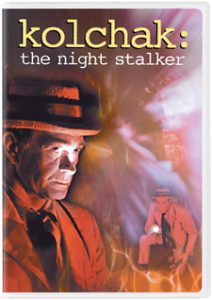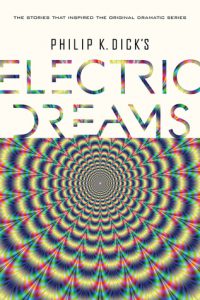Even if you’ve watched Amazon Prime’s “Philip K. Dick’s Electric Dreams,” you still don’t know the 10 short stories they came from. The teleplay writers tended to be inspired by the yarns more so than doing straight adaptations of them. The good news is that you now have 10 more pieces of “Electric Dreams” entertainment, collected in a 2017 tome from British publisher Gollancz. Each story has a short introduction from the teleplay writer.
Here are my rankings of the stories, along with thoughts on how they differ from the TV version:
1. “The Hood Maker” (1955)
While the TV episode makes the teeps (telepaths) sympathetic, here they are villains. Still, I like the short story better, as it more robustly shows us a future where the notion of privacy has faded, and where “Guilty until proven innocent” is the law’s guiding principle. (Perversely, this dictate makes coldly logical sense in a completely transparent society.)

“Philip K. Dick’s Electric Dreams” (2017)
Reprinting of 10 short stories adapted for the TV series
Author: Philip K. Dick
Genre: Science fiction
Predictably, those who wish to enjoy private thoughts via the hood are assumed to be hiding something. But “The Hood Maker” rises from a lecture piece into a potboiler, as we see the teeps’ clever power-play unfold and the even more clever way that the protagonist, Cutter, outsmarts them.
2. “Foster, You’re Dead” (1955)
The adaptation, “Safe and Sound,” is my favorite of the 10 episodes for how it illustrates the behind-the-scenes functions of a totalitarian state, but I like PKD’s version for different reasons. Inspired by the equally inescapable Cold War paranoia and rise of mass advertising, PKD delves into the less-talked-about third tier to the military-industrial complex: the way fear is used as a selling tool on the consumer-goods market.
While Bob Foster is a typical beleaguered patriarch pressured to conform, the most harrowing character is his son Mike, whose favorite thing to do is curl up in the family’s bomb shelter, enjoying the feeling of protection. Dick set this story less distantly in the future than he usually does, 1972. Although he overestimated how soon children would abandon unstructured outside playtime in favor of doing nothing indoors, he deserves credit for seeing the shift coming.
3. “Autofac” (1955)
Harlan Ellison famously sued “The Terminator” for ripping off his short story “Soldier Out of Time,” resulting in an “inspired by” credit on the 1984 film. If the estate of PKD had been as litigious, it would’ve had an excellent shot at the same outcome for “Autofac.” This is a more realistic version of the “Terminator” backstory (and the “Electric Dreams” episode), because the automated factories don’t gain sentience, but rather they are nearly unstoppable BECAUSE they are not sentient.
They just do what they do, and in a bombed-out future, our heroes must figure out how to communicate with the non-abstract autofac computers to get them to stop producing useless goods and exhausting resources. It works as a prescient and parodic tale about the frustrations of trying to get good customer service, something less visceral than killer robots, but perhaps scarier.

4. “The Hanging Stranger” (1953)
The TV version, “Kill All Others,” cleverly ferrets out the 21st century political commentary so deeply buried in the short story that PKD himself might not have known it was there. Dick’s version is simple: Ed Noyce is the only one bothered by a dead stranger hanging in the town square. This is because most of the population has been body-snatched by aliens, who are using the dead man as a canary in the coal mine to draw out the humans who haven’t yet been possessed. (If you’re wondering, the first “Invasion of the Body Snatchers” movie didn’t come out until 1956.)
5. “Exhibit Piece” (1954)
The TV episode is a straight mind-puzzle asking “Which of the two realities is real?” But PKD’s short story is nostalgic, as George Miller lives in the future but longs for the past. It’s impressive that Dick expresses a longing for the “Father Knows Best” elements of the 1950s while writing in the 1950s, as if he projected his mind into the future in order to get into George’s mindset. As with the TV ep, a case can be made for both realities, so George picks the one he likes more: The flawed but pleasant past over the safe but stultifying future. We’ll never know if he would’ve chosen differently if he knew the bomb was coming.
6. “Sales Pitch” (1954)
This one is the most wildly different from its TV counterpart; the fact of a door-to-door salesperson is the only common element. Here, PKD illustrates the linked phenomena of pushy salesmen and (as in “Foster, You’re Dead”) societal pressure to consume, in the form of a robot that invades Ed Morris’ home to sell itself. “Suppose I never buy you?” Ed asks. “Eventually you’ll buy me,” the robot responds, having seen this all before. PKD and Ed lose their minds in unison as the narrative unwinds, with Ed flying his space-car outside the solar system in a futile attempt to escape the robot and its constant advertising.
7. “The Commuter” (1953)
Mirroring the “Exhibit Piece” conundrum, Bob Paine must choose between two realities, but here he knows the happy suburb of Macon Heights is fake and his imperfect life in the gloomy big city is real. But the city does include his wife and kid, and he suspects he’ll never see them again if he gives himself over to the Macon Heights utopia. A structural oddity of this piece is that ticket seller Ed Jacobson starts off as the protagonist, then PKD switches over to Ed’s boss, Bob. The TV ep allows us to invest in one central character, Ed, which gives it an edge over the source material.
8. “Human Is” (1955)
The twists at the end are not precisely the same, but the plot is quite similar to the TV version. Lester Herrick is a jerk to his wife, Jill; he gets body-snatched by an alien; Jill decides she prefers the new “Lester.” Dick’s version is better than the TV ep partly because it’s tighter, but it’s also more chilling: Here, we are told that the real Lester is not dead (as in the episode), but is being held captive on Rexor IV. So by accepting the alien as the new Lester, she is condemning her husband, forcing us to ask: At what point is a human so nasty that they deserve an awful fate?
9. “The Father-Thing” (1954)
Like “The Hanging Stranger” and “Human Is,” this is a body-snatcher piece, and of the 10 stories, it’s the most similar to its TV version. But the TV ep is actually better because it adds a Rockwellian backstory to the father-son relationship, giving emotional heft to the alien takeover of the dad’s body rather than throwing us right into the action as PKD does.
10. “The Impossible Planet” (1953)
This one is plotted the same as the TV episode, but the path diverts with a twist ending where we learn that Emphor III actually IS the dead planet Earth. This raises the disturbing question of how Earth was forgotten and accidentally renamed in the span of just a few centuries. (By comparison, in Isaac Asimov’s “Foundation” novels, enough generations have passed that Earth has believably been lost to the sands of time.) While the question of how humanity could forget its roots so quickly is fascinating, it also goes blatantly unanswered, making “Impossible Planet” feel incomplete.
How would you rank the 10 short stories in “Electric Dreams?” Share your list in the comment thread.

